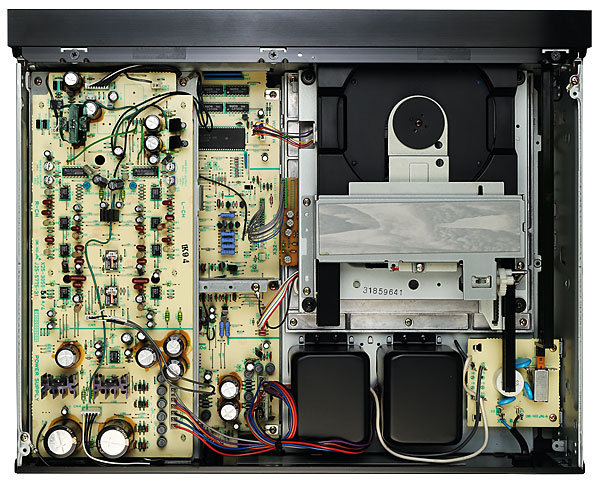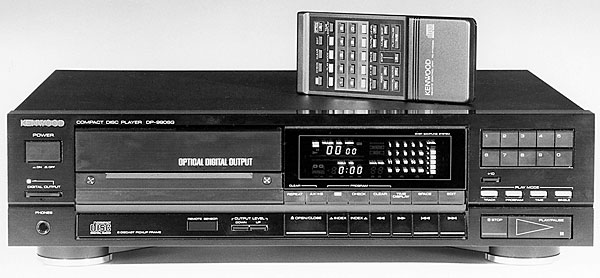Kenwood DP-1100SG CD Player Page 2
![]() Tim Listens
Tim Listens
Hearing top-of-the-range CD players from large manufacturers is always an interesting exercise. There is no reason to expect anything other than perfection, given the resources that could have been called upon at the design stage and the self-evident quality of the components used. Sound quality outcomes can therefore be considered a matter of the designer's taste rather than the result of any technical (or financial) limitations imposed on the project. It's safe to say a flagship player sounds the way it does because that's what someone wanted.
The first thing that struck me about the DP-1100SG's presentation was the broad and continuous soundstage it was able to conjure up. It generated a genuinely room-filling performance, and with a well produced recording it was easy to identify the origin of each and every sound in the mix with pinpoint accuracy.

Meanwhile, instruments and voices were crisp and detailed, and while this couldn't be described as a smooth-sounding player as such, there was little evidence of coarseness or granularity either. These qualities alone would have justified the high initial cost of this model, at least when compared to the Japanese competition of the day.
The sound wasn't perfect though – to my ears a touch bass light and dry. This is a shame, as it would have been wonderful to fill that big soundstage with a bit of low-end weight, so as to recreate the excitement of a genuine orchestral experience. The lack of bass extension seemed to make the upper midband prominent too, giving some music a hard, bland character.
Listening to the Hallelujah chorus of Handel's Messiah [Philips 426 689-2] at a realistic level made all the Kenwood DP-1100SG's virtues plainly evident. The string section in particular sounded vivid without being strident, although the higher registers of the vocals were perhaps a little too hard-sounding until one turned down the volume knob on the amp.
My biggest regret, though, was that the timpani drums sounded weak and distant when compared to hearing the same recording on another machine. Loudspeaker choice and positioning may remedy this perceived shortcoming, and it is certainly worth experimenting given the other strengths of this player.

All The Notes
Popular music revealed another side to the DP-1100SG. The tangle of complex studio mixes caused no problem for the player's fine sense of focus – for those who wish to study the exact construction of a particular track this could be the ideal tool. Having heard it on the DP-1100SG, I think I could have a reasonable stab at explaining how songs such as 'Dancing With Tears In My Eyes' by Ultravox from the Best Of compilation [EMI 5358112] were put together. It's almost like having the location of individual instruments on the studio's multi-track tape listed in the CD liner notes for you.
From an enjoyment point of view the lack of proper bass extension remained an issue, however. Indeed, it had me wondering what the set-up used by the development engineers was like. Massive ported three-way loudspeakers pushed into the corners of the lab, perhaps?
That said, I found it of interest that the Kenwood DP-1100SG gave similar results, subjectively speaking at least, to the Sony CDP-502ES II and the rare, but oh-so-beautifully finished, JVC XL-V1100 (no relation, despite the similarity of the model number).

Neither of these players were cheap, yet both sound restrained and a trifle bland when compared to period rivals such as the Technics SL-P1200 [HFN Aug '13] and Philips CD960/Marantz CD-94 [HFN Jul '20]. Just a few years ago it would have been simple and inexpensive to simply have one of each, but that's a far more complex and costly undertaking these days.
Buying Secondhand
The DP-1100SG isn't an especially common player so finding one may prove difficult. Make sure the machine on offer is what you think it is: the 'D' and 'SG' variants look very similar, while the more affordable DP-990SG is a lookalike. It is also worth holding out for a sample that comes with its remote handset as this is unusually well thought out and useful – especially the output level control.

While the design is tough and durable, some parts, such as the optical unit, were rarely used elsewhere so it can be difficult to find replacements. Contrast this with models like the Philips CD960 which uses the same deck found in a whole range of popular machines. The heavy drawer mechanism takes its toll on the belts that drive it but these at least are obtainable and reasonably straightforward to fit.
One thing in the DP-1100SG's favour is the excellent service manual that Kenwood prepared for it. The manual for the original DP-1100B was virtually a treatise on how the complete CD system worked, starting with basic optical principles and data coding techniques before leading to a full circuit description. The one for the SG isn't quite as comprehensive, but it is still an example of best practice as far as service data is concerned.
Hi-Fi News Verdict
This rare top-end player is a beautifully engineered and immaculately presented product that no doubt works just as its designers intended. It's a regret, then, that it doesn't sound a bit more exciting and that a little more bass wasn't allowed for. This would have elevated the player's performance from being good to seriously impressive. It's still worth seeking out, even if there are not too many to be found.























































